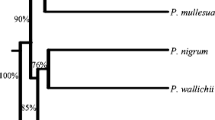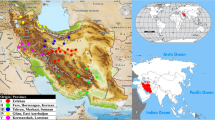Abstract
Nineteen species of rose (Rosa sp.) were analysed using Random Amplified Polymorphic DNA markers (RAPD). Each 10-base-long arbitrary primer produced a specific DNA banding pattern that grouped plants belonging to the same species and botanical sections as predicted from their genetic background. One hundred and seventy-five amplification products were examined by cluster analysis to assess the genetic relationships among species and their genetic distances. All of the accessions belonging to 1 species grouped together before branching to other species. Dendrograms constructed for intra- and inter-specific studies showed a good correlation with previous classifications by different authors based on morphological and cariological studies. Our results show that the RAPD technique is a sensitive and precise tool for genomic analysis in rose, being useful in assigning unclassified accessions to specific taxonomic groups or else allowing accessions classified by traditional criteria to be re-classified.
Similar content being viewed by others
References
Bean WJ (1970) Rosa. In: Clarke D. L., Taylor G. (eds) Trees and shrubs hardy in the British Isles, Vol 4, 8th edn. John Murray, London, pp 35–152
Bhat KV, Jarret RL (1995) Random amplified polymorphic DNA and genetic diversity in Indian Musa germplasm. Genet Resources Crop Evol 42:107–118
Darlington CD (1973) Chromosome botany and the origin of cultivated plants, 3rd edn. Hafner press, New York
Debener T, Salamini F, Gebhardt C(1990) Phylogeny of wild and cultivated Solanium species based on nuclear restriction fragment length polymorphism (RFLPs). Theor Appl Genet 79:360–368
Facsar G, Popek R, Malecka J (1991) Taxonomisch-karyologische Untersuchungen an wilden Rosen aus Ungarn und anderen euro-päischen Länder. Fragm Flor Geobot 36:293–300
Gustafsson A (1944) The constitution of the rosa canina complex. Hereditas 30:405–428
Hurst CC (1941) Notes on the origin and evolution of our garden roses. J R Hortic Soc 66:73–82, 242–250, 282–289
Klastersky I (1968) Rosa L. In: Tutin TG, Heywood VH, Burges NA, Moore DM, Valentine DH, Walters SM, Webb DA (eds) Flora Europaea, vol. 2. Cambridge University Press, London, PP 25–32
Krüssman G (1986) Rosen, rosen, rosen. Verlag Paul Parey, Frankfurt
Millán T, Torres AM, Cubero JI (1995) Varietal identification in Rosa by using isozymes and RAPD markers. In: Anonymous 2nd Int Rose Symp. ISHS/INRA Antibes, France (in press)
Miller JC, Tanksley SD (1990) RFLP analysis of phylogenetic relationships and genetic variation in the genus Lycopersicon. Theor Appl Genet 80:437–448
Rohlf FJ (1989) NTSTS-pc numerical taxonomy and multivariate analysis system. Exeter Publ, New York
Sneath PHA, Sokal RR (1973) Numerical taxonomy, the principles and practice of numerical classification. W. H. Freeman and Co, San Francisco
Stiles JI, Lemme C, Sondur S, Morshidi MB, Manshardt R (1993) Using randomly amplified polymorphic DNA for evaluating genetic relationships among papaya cultivars. Theor Appl Genet 85:697–701
Torres AM, Millán T, Cubero JI (1993) Identifying rose cultivars using Random Amplified Polymorphic DNA markers. Hort-Science 28:333–334
Torres AM, Millán T, Moreno MT, Cubero JI (1995) Use of molecular markers in taxonomic studies of Rosa sp. In: Anonymous 2nd Int Rose Symp. ISHS/INRA, Antibes, France (in press)
Waugh R, van de Ven WTG, Philips MS, Powell W (1990) Chloroplast DNA diversity in the genus Rubus (Rosaceae) revealed by Southern hybridisation. Plant Syst Evol 172:65–75
Welsh J, McClelland M (1990) Fingerprinting genomes using PCR with arbitrary primers. Nucleic Acids Res 18:7213–7218
Welsh J, Petersen C, McClelland M (1991) Polymorphisms generated by arbitrarily primed PCR in the mouse: application to strain identification and genetic mapping. Nucleic Acids Res 19:303–306
Williams JGK, Kubelik AR, Livak KJ, Rafalski JA, Tingey SV (1990) DNA polymorphism amplified by arbitrary primers are useful as genetic markers. Nucleic Acids Res 18:6531–6535
Wylie AP (1954 a) Masters Memorial Lecture 1954: the history of garden roses. J R Hortic Soc 79:555–571
Wylie AP (1954 b) Chromosomes of garden roses. Am Rose Annu 1954:36–66
Zielinski J (1985) Studia nad rodzajem Rosa L. — Systematyka sekeji Caninae DC. em. Christ. Arbor Kórnickie 30:3–109
Author information
Authors and Affiliations
Additional information
Communicated by J. Mac Key
Rights and permissions
About this article
Cite this article
Millan, T., Osuna, F., Cobos, S. et al. Using RAPDs to study phylogenetic relationships in Rosa . Theoret. Appl. Genetics 92, 273–277 (1996). https://doi.org/10.1007/BF00223385
Received:
Accepted:
Issue Date:
DOI: https://doi.org/10.1007/BF00223385




